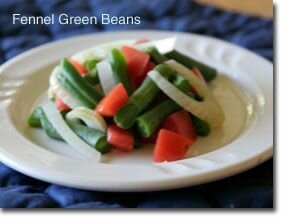If you don't know what to serve for dinner tonight ...
Try this creative combination of fennel and green beans for a tasty addition to your Healthiest Way of Eating. And it only takes minutes to prepare!

Ingredients:
- 3 cups thin green beans
- 1/2 cup sliced fennel bulb
- 1/2 medium onion, sliced
- 1 fresh tomato, seeds and excess pulp removed, chopped
- 2 TBS fresh lemon juice
- 1 TBS extra virgin olive oil
- salt and cracked black pepper to taste
- Slice onion and let sit for 5-10 minutes to bring out its health-promoting properties.
- Bring water to a boil in a steamer with a tight fitting lid.
- Cut ends off beans and cut into 1-2 inch pieces. Slice fennel and onion.
- Steam beans and onion together for about 3 minutes, and add fennel. Steam for another 2 minutes. Drain well and pat with paper towel so any excess water does not dilute taste.
- Toss with rest of ingredients.
In-Depth Nutritional Profile for Fennel Green Beans
Healthy Food Tip
The Latest News About Green Beans
It's impossible to describe the potential health benefits of green beans and not mention bone health. Although we have yet to see research documentation in this area, we expect to see studies that document green bean support of bone health for five basic reasons: namely, its concentration of silicon, vitamin K, calcium, magnesium and phosphorus. The strong carotenoid and flavonoid content of green beans also appears to give this vegetable some potentially unique anti-inflammatory benefits.
What's New and Beneficial About Green Beans
- Because of their rich green color, we don't always think about green beans as providing us with important amounts of colorful pigments like carotenoids. But they do! Recent studies have confirmed the presence of lutein, beta-carotene, violaxanthin, and neoxanthin in green beans. In some cases, the presence of these carotenoids in green beans is comparable to their presence in other carotenoid-rich vegetables like carrots and tomatoes. The only reason we don't see these carotenoids is because of the concentrated chlorophyll content of green beans and the amazing shades of green that it provides.
- You can enjoy green beans while supporting food sustainability! Recent surveys have shown that 60% of all commercially grown green beans are produced in the United States, with large amounts of green bean acreage found in the states of Illinois, Michigan, New York, Oregon, and Wisconsin. Although countries like France, Mexico, Iraq, and Argentina are large-scale producers of green beans, there is plenty of this delicious vegetable available in our own backyard.
- If you are unable to obtain fresh green beans, you can still get many valuable nutrients from green beans that have been frozen or canned. We like fresh greens the best! But we realize that access to them can sometimes be a problem. When first frozen and then cooked, retention of some B vitamins in green beans (like vitamins B6 and B2) can be as high as 90%. Recent studies have shown that canned green beans—on average—lose about one third of their phenolic compounds during the canning process. They lose B vitamins as well—but in the case of some B vitamins like folic acid, as little as 10%.
- Green beans (referred to as "string beans" by the study authors) have recently been shown to have impressive antioxidant capacity. Research comparing the overall antioxidant capacity of green beans to other foods in the pea and bean families (for example, snow peas or winged beans) has found green beans to come out on top, even though green beans are not always highest in their concentration of specific antioxidant nutrients like phenolic acids or vitamin C. It's not surprising to find recent studies highlighting the antioxidant capacity of green beans! Researchers now know that the list of antioxidant flavonoids found in green beans is not limited to quercetin and kaemferol but also includes flavonoids like catechins, epicatechins, and procyanidins. Researchers also know that the antioxidant carotenoids in this vegetable are diverse, and include lutein, beta-carotene, violaxanthin, and neoxanthin, as noted above.
- Green beans may be a particularly helpful food for providing us with the mineral silicon. This mineral—while less well known that minerals like calcium and magnesium—is very important for bone health and for healthy formation of connective tissue. Green beans have recently been shown to stack up quite well against other commonly-eaten foods as a good source of absorbable silicon.
WHFoods Recommendations
To retain the maximum number of health-promoting phytonutrients and
vitamins and minerals found in green beans, we recommend Healthy
Steaming them for just 5 minutes. This also brings out their peak flavor
and provides the moisture necessary to make them tender, and retain
their beautifully bright green color. It is best to cook green beans
whole to ensure even cooking. For more on the Healthiest Way of Cooking
Green Beans, see the How to Enjoy section of the green beans write-up on the website.
Health Benefits
Green provide numerous health benefits including:
- Antioxidant and anti-inflammatory properties
- Cardiovascular health support
- Bone health promotion
Nutritional Profile
Green beans are an important source of both carotenoids and
flavonoids. Green bean carotenoids include lutein, beta-carotene,
violaxanthin, and neoxanthin. Green bean flavonoids include quercetin,
kaemferol, catechins, epicatechins, and procyanidins Green beans are an
excellent source of free radical-scavenging vitamin C and manganese, and
bone-building vitamin K. They are also a very good source of
immune-supportive, vitamin A; heart-healthy dietary fiber, potassium,
and folate; and energy-producing iron. In addition, green beans are a
good source of bone-building magnesium, calcium, phosphorus, and copper;
energy-producing thiamin, riboflavin, and niacin; muscle-enhancing
protein; and anti-inflammatory omega-3 fatty acids. Green beans have
also been shown to contain valuable amounts of the mineral silicon, and
in a form that makes
For more on this nutrient-rich vegetable, including references related to this Latest News, see our write-up green beans.

No comments:
Post a Comment